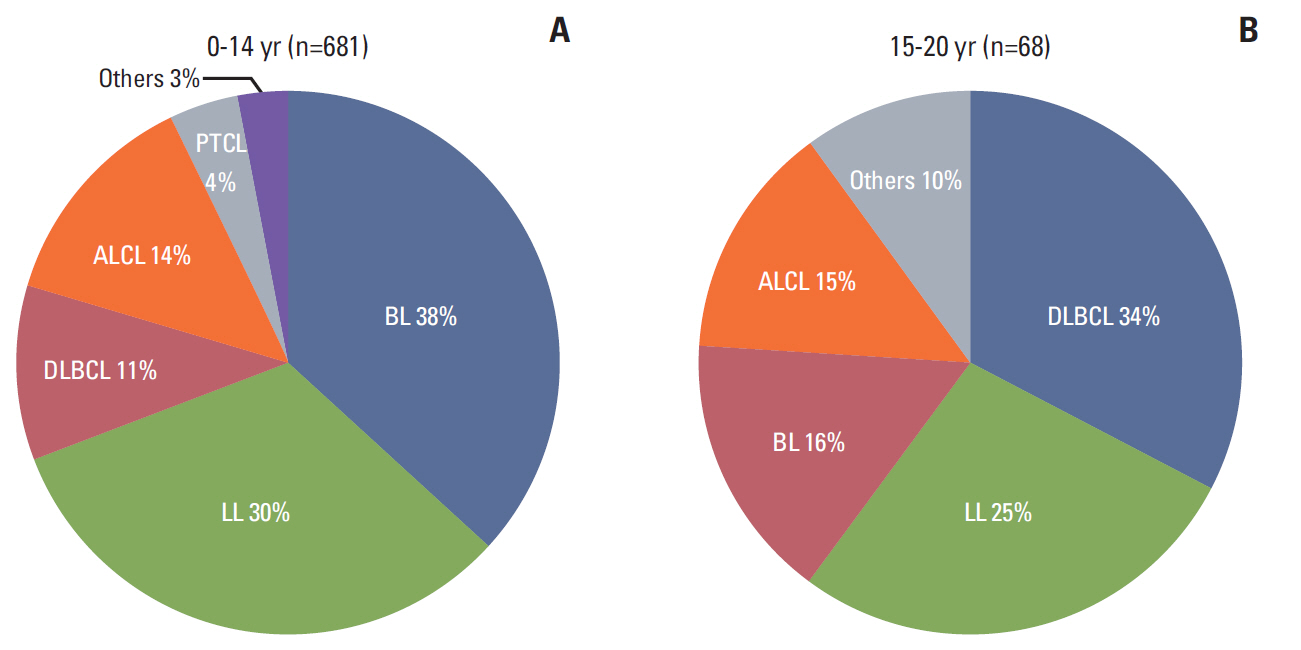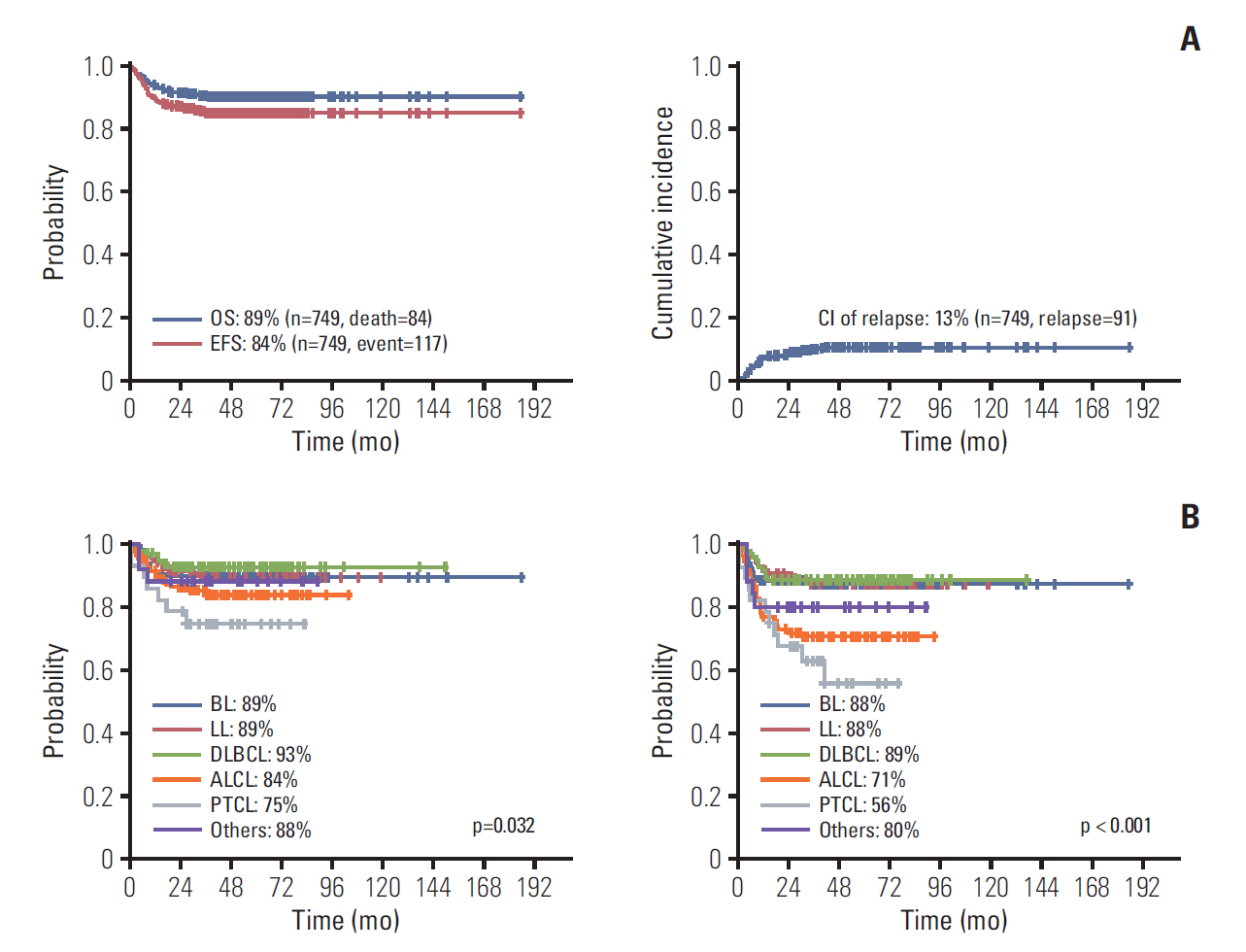Cancer Res Treat.
2020 Apr;52(2):359-368. 10.4143/crt.2019.219.
Clinical Characteristics and Treatment Outcomes of Pediatric Patientswith Non-Hodgkin Lymphoma in East Asia
- Affiliations
-
- 1Division of Pediatric Hematology/Oncology, Department of Pediatrics, Asan Medical Center Children’s Hospital, University of Ulsan College of Medicine, Seoul, Korea
- 2Department of Hematology/Oncology, Shanghai Children’s Medical Center, Shanghai, China
- 3Department of Pediatrics Hematology/Oncology, National Taiwan University Hospital, Taipei, Taiwan
- 4Department of Pediatrics, Nagoya University Graduate School of Medicine, Nagoya, Japan
- 5Hematology Oncology Center, Beijing Children’s Hospital, Capital Medical University, Beijing, China
- KMID: 2500321
- DOI: http://doi.org/10.4143/crt.2019.219
Abstract
- Purpose
The presentations and geographic incidence of pediatric non-Hodgkin lymphoma (NHL) differ from those of adults. This study delineated the characteristics and outcomes of pediatric NHL in East Asia.
Materials and Methods
Medical records of 749 pediatric patients with NHL treated at participating institutions in mainland China, Japan, Korea, and Taiwan from January 2008 to December 2013 were reviewed. Demographic and clinical features, survival outcomes, and putative prognostic factors were analyzed.
Results
Five hundred thirty patients (71%) were male. The most common pathologic subtypes were Burkitt lymphoma (BL) (36%). Six hundred seven patients (81%) had advanced diseases at diagnosis. The 5-year overall survival and event-free survival (EFS) rates were 89% and 84%. The 5-year EFS rates of BL, lymphoblastic lymphoma, and diffuse large B-cell lymphoma were 88%, 88%, and 89%, and those of anaplastic large cell lymphoma (ALCL) and peripheral T-cell lymphoma (PTCL) were 71% and 56% (p < 0.001). Central nervous system involvement, high lactate dehydrogenase level (> 250 IU/mL), and advanced disease at diagnosis ( stage III) were associated with poor outcomes (p < 0.05). ALCL and PTCL relapsed more frequently than other pathologic subtypes (p < 0.001).
Conclusion
In East Asia, PTCL was more frequent than in Western countries, and bone marrow involvement did not affect treatment outcome. This international study should motivate future collaborative study on NHL in East Asia.
Keyword
Figure
Reference
-
References
1. Reiter A, Schrappe M, Parwaresch R, Henze G, Muller-Weihrich S, Sauter S, et al. Non-Hodgkin's lymphomas of childhood and adolescence: results of a treatment stratified for biologic subtypes and stage: a report of the Berlin-Frankfurt-Munster Group. J Clin Oncol. 1995; 13:359–72.2. Reiter A, Schrappe M, Tiemann M, Ludwig WD, Yakisan E, Zimmermann M, et al. Improved treatment results in childhood B-cell neoplasms with tailored intensification of therapy: a report of the Berlin-Frankfurt-Munster Group Trial NHL-BFM 90. Blood. 1999; 94:3294–306.3. Minard-Colin V, Brugieres L, Reiter A, Cairo MS, Gross TG, Woessmann W, et al. Non-Hodgkin lymphoma in children and adolescents: progress through effective collaboration, current knowledge, and challenges ahead. J Clin Oncol. 2015; 33:2963–74.
Article4. Lymphoma Study Group, Subspecialty Group of Hematology, the Society of Pediatrics, Chinese Medical Association; Lymphoma Study Group Committee of Pediatrics Chinese Anti-Cancer Association. A collaborative study of children with lymphoblastic non-Hodgkin's lymphoma in China. Zhonghua Er Ke Za Zhi. 2015; 53:931–7.5. Mitsui T. Recent progress in the treatment of pediatric lymphoma in Japan. Rinsho Ketsueki. 2017; 58:2168–77.6. Hwang IG, Yoo KH, Lee SH, Park YH, Lim TK, Lee SC, et al. Clinicopathologic features and treatment outcomes in malignant lymphoma of pediatric and young adult patients in Korea: comparison of Korean all-ages group and Western younger age group. Clin Lymphoma Myeloma. 2007; 7:580–6.
Article7. Sabattini E, Bacci F, Sagramoso C, Pileri SA. WHO classification of tumours of haematopoietic and lymphoid tissues in 2008: an overview. Pathologica. 2010; 102:83–7.8. Murphy SB. Classification, staging and end results of treatment of childhood non-Hodgkin's lymphomas: dissimilarities from lymphomas in adults. Semin Oncol. 1980; 7:332–9.9. Burkhardt B, Zimmermann M, Oschlies I, Niggli F, Mann G, Parwaresch R, et al. The impact of age and gender on biology, clinical features and treatment outcome of non-Hodgkin lymphoma in childhood and adolescence. Br J Haematol. 2005; 131:39–49.
Article10. Hochberg J, Waxman IM, Kelly KM, Morris E, Cairo MS. Adolescent non-Hodgkin lymphoma and Hodgkin lymphoma: state of the science. Br J Haematol. 2009; 144:24–40.
Article11. Kontny U, Oschlies I, Woessmann W, Burkhardt B, Lisfeld J, Salzburg J, et al. Non-anaplastic peripheral T-cell lymphoma in children and adolescents: a retrospective analysis of the NHL-BFM study group. Br J Haematol. 2015; 168:835–44.12. Anderson JR, Armitage JO, Weisenburger DD. Epidemiology of the non-Hodgkin's lymphomas: distributions of the major subtypes differ by geographic locations. Non-Hodgkin's Lymphoma Classification Project. Ann Oncol. 1998; 9:717–20.13. Vose J, Armitage J, Weisenburger D; International T-Cell Lymphoma Project. International peripheral T-cell and natural killer/T-cell lymphoma study: pathology findings and clinical outcomes. J Clin Oncol. 2008; 26:4124–30.14. Reiter A, Schrappe M, Ludwig WD, Tiemann M, Parwaresch R, Zimmermann M, et al. Intensive ALL-type therapy without local radiotherapy provides a 90% event-free survival for children with T-cell lymphoblastic lymphoma: a BFM group report. Blood. 2000; 95:416–21.15. Brugieres L, Deley MC, Pacquement H, Meguerian-Bedoyan Z, Terrier-Lacombe MJ, Robert A, et al. CD30(+) anaplastic large-cell lymphoma in children: analysis of 82 patients enrolled in two consecutive studies of the French Society of Pediatric Oncology. Blood. 1998; 92:3591–8.16. Cairo MS, Krailo MD, Morse M, Hutchinson RJ, Harris RE, Kjeldsberg CR, et al. Long-term follow-up of short intensive multiagent chemotherapy without high-dose methotrexate ('Orange') in children with advanced non-lymphoblastic non-Hodgkin's lymphoma: a children's cancer group report. Leukemia. 2002; 16:594–600.
Article17. Williams DM, Hobson R, Imeson J, Gerrard M, McCarthy K, Pinkerton CR, et al. Anaplastic large cell lymphoma in childhood: analysis of 72 patients treated on the United Kingdom Children's Cancer Study Group chemotherapy regimens. Br J Haematol. 2002; 117:812–20.
Article18. Marky I, Bjork O, Forestier E, Jonsson OG, Perkkio M, Schmiegelow K, et al. Intensive chemotherapy without radiotherapy gives more than 85% event-free survival for non-Hodgkin lymphoma without central nervous involvement: a 6-year population-based study from the nordic society of pediatric hematology and oncology. J Pediatr Hematol Oncol. 2004; 26:555–60.19. Cairo MS, Gerrard M, Sposto R, Auperin A, Pinkerton CR, Michon J, et al. Results of a randomized international study of high-risk central nervous system B non-Hodgkin lymphoma and B acute lymphoblastic leukemia in children and adolescents. Blood. 2007; 109:2736–43.
Article20. Patte C, Auperin A, Gerrard M, Michon J, Pinkerton R, Sposto R, et al. Results of the randomized international FAB/LMB96 trial for intermediate risk B-cell non-Hodgkin lymphoma in children and adolescents: it is possible to reduce treatment for the early responding patients. Blood. 2007; 109:2773–80.
Article21. Cairo MS, Sposto R, Gerrard M, Auperin A, Goldman SC, Harrison L, et al. Advanced stage, increased lactate dehydrogenase, and primary site, but not adolescent age (≥ 15 years), are associated with an increased risk of treatment failure in children and adolescents with mature B-cell non-Hodgkin's lymphoma: results of the FAB LMB 96 study. J Clin Oncol. 2012; 30:387–93.
Article22. Mussolin L, Pillon M, d'Amore ES, Conter V, Piglione M, Lo Nigro L, et al. Minimal disseminated disease in high-risk Burkitt's lymphoma identifies patients with different prognosis. J Clin Oncol. 2011; 29:1779–84.
Article23. Coustan-Smith E, Sandlund JT, Perkins SL, Chen H, Chang M, Abromowitch M, et al. Minimal disseminated disease in childhood T-cell lymphoblastic lymphoma: a report from the children's oncology group. J Clin Oncol. 2009; 27:3533–9.
Article24. Shiramizu B, Goldman S, Kusao I, Agsalda M, Lynch J, Smith L, et al. Minimal disease assessment in the treatment of children and adolescents with intermediate-risk (Stage III/IV) B-cell non-Hodgkin lymphoma: a children's oncology group report. Br J Haematol. 2011; 153:758–63.
Article25. Le Deley MC, Reiter A, Williams D, Delsol G, Oschlies I, McCarthy K, et al. Prognostic factors in childhood anaplastic large cell lymphoma: results of a large European intergroup study. Blood. 2008; 111:1560–6.
Article26. Burkhardt B, Reiter A, Landmann E, Lang P, Lassay L, Dickerhoff R, et al. Poor outcome for children and adolescents with progressive disease or relapse of lymphoblastic lymphoma: a report from the berlin-frankfurt-muenster group. J Clin Oncol. 2009; 27:3363–9.
Article27. Kim H, Park ES, Lee SH, Koo HH, Kim HS, Lyu CJ, et al. Clinical outcome of relapsed or refractory burkitt lymphoma and mature B-cell lymphoblastic leukemia in children and adolescents. Cancer Res Treat. 2014; 46:358–65.
Article28. Topp MS, Gokbuget N, Stein AS, Zugmaier G, O'Brien S, Bargou RC, et al. Safety and activity of blinatumomab for adult patients with relapsed or refractory B-precursor acute lymphoblastic leukaemia: a multicentre, single-arm, phase 2 study. Lancet Oncol. 2015; 16:57–66.
Article29. Pishko A, Nasta SD. The role of novel immunotherapies in non-Hodgkin lymphoma. Transl Cancer Res. 2017; 6:93–103.
Article30. Batlevi CL, Matsuki E, Brentjens RJ, Younes A. Novel immunotherapies in lymphoid malignancies. Nat Rev Clin Oncol. 2016; 13:25–40.
Article
- Full Text Links
- Actions
-
Cited
- CITED
-
- Close
- Share
- Similar articles
-
- A Case of Nasal Extranodal NK/T Cell Lymphoma Misdiagnosed as Reccurent Periorbital Cellulitis or Acute Dacryocystitis
- Pathologic Characteristics and Differential Diagnosis of Hodgkin Lymphoma
- A Case of NK/T Cell Lymphoma in Sinonasal Tract
- A Clinical Study of Childhood Non-Hodgkin's Lymphoma
- Composite follicular lymphoma and classic Hodgkin lymphoma




